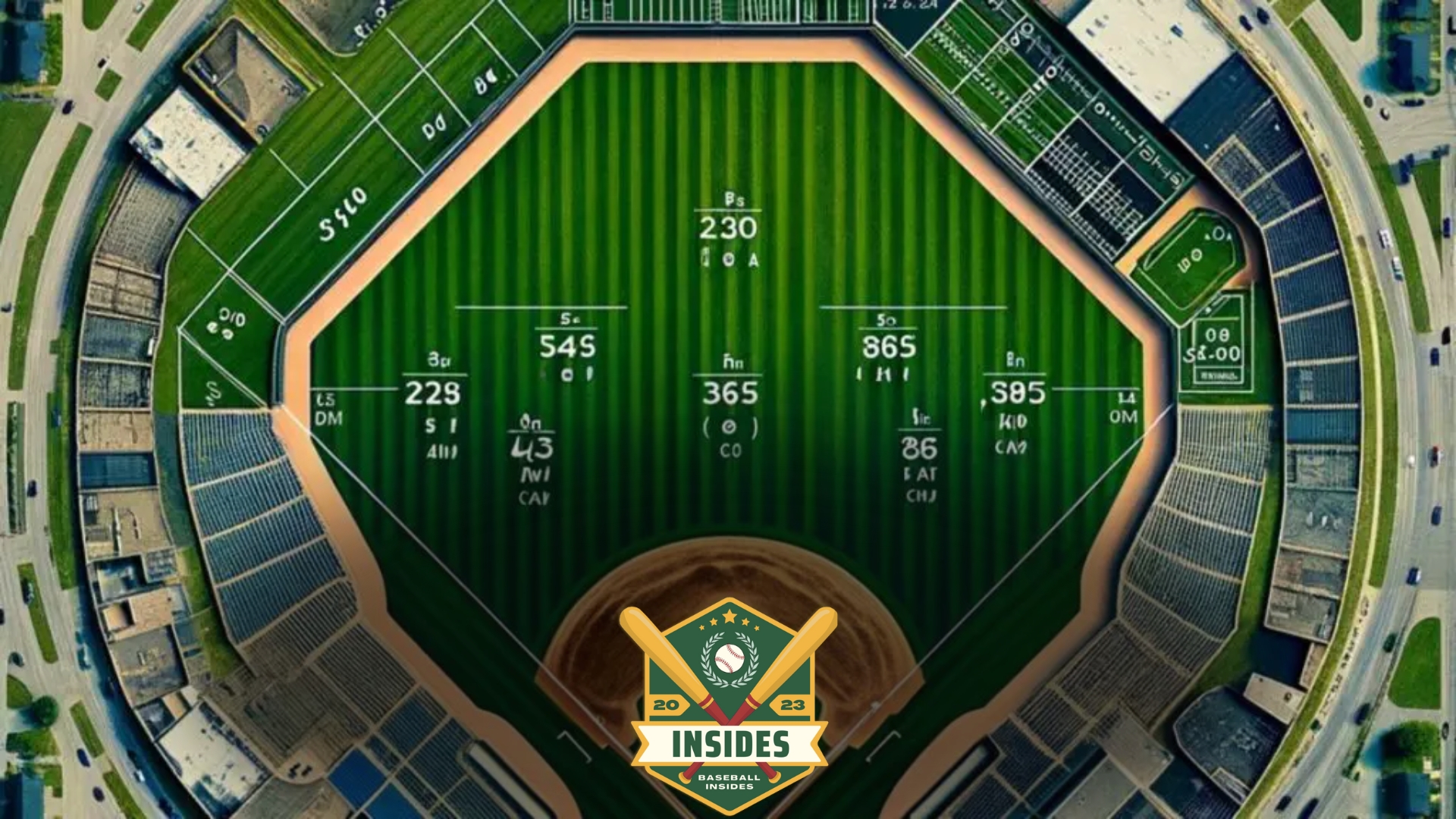
In this article:
Have you ever watched a baseball game and wondered about the size of the field? Well, you’re not alone! Many baseball enthusiasts share this curiosity. So, let’s dive right into it.
A typical baseball field, with a distance of 90 feet between the bases and a 400-foot centerfield fence, covers a surprising amount of ground. This includes not just the infield and outfield but also the foul territory.
Ready for the revelation? A standard baseball field spans approximately 125,000 square feet. This equals to around 4.5 acres!
So, the next time you watch a game, you can impress your friends with this fun fact. Stay tuned as we further explore the fascinating dimensions of a baseball field!
The Different Sections of a Baseball Field
Before we take a deep dive into the acreage of a baseball field, it’s crucial to understand its different sections. A baseball field, often called a baseball diamond, comprises several distinct parts, each with a unique role.
The Infield
The infield, the heart of the baseball field, is where most of the action takes place. A square-shaped area, it’s home to the main bases – first, second, and third base and the home plate.
The Outfield
The outfield, the vast expanse beyond the infield, is typically grassy and open. It’s divided into the left, center, and right fields. This is where outfielders catch fly balls and prevent the opposing team from scoring.
The Pitcher’s Mound
The pitcher’s mound, located in the center of the infield, is where the pitcher stands and throws the ball toward the home plate. It is slightly elevated, giving the pitcher a height advantage.
The Dugouts
On either side of the field are the dugouts – exclusive areas for the team members not currently in play. They provide shelter and a good view of the game, making it easier to strategize and plan next moves.
The Warning Track
Lastly, we have the warning track. This is a strip of dirt that runs along the outfield wall. It’s designed to warn outfielders they’re approaching the wall, helping to prevent injuries.
Now, with a clear understanding of these sections, we’re set to explore the overall area of a baseball field.
While exploring the dimensions and vastness of a baseball field, you might find yourself curious about other aspects of the game, such as the Mercy Rule in Baseball, which plays a crucial role in maintaining the spirit and competitiveness of the game.
The Distance Between Bases Explained
Ever wondered about the distance between bases on a baseball field? It’s a key component that determines the size of the entire field. Let’s delve into it.
Standard Measurements
Major League Baseball (MLB) ‘s standard distance between each base is exactly 90 feet. This forms a perfect square or a “diamond,” as it’s often called in the baseball world. These measurements are uniform across all MLB fields.
Why 90 Feet?
The 90-foot distance wasn’t just randomly chosen. The optimal distance creates a balanced challenge between the runner and the fielder. Any shorter, the fielders would have an unfair advantage; any longer, the advantage would tilt towards the runners.
Path of the Runner
When players hit the ball and run to first base, they can run outside the baseline and onto the grass. This is because the distance from home plate to first base, measured along the foul line, is only 87 feet.
Youth Leagues
In youth leagues, the bases are set closer together. The exact distance can vary, generally from 60 to 70 feet. This is done to accommodate the younger players’ strength and speed.
So, there you have it. The distance between each base is a crucial part of baseball that is thoughtfully determined to ensure fair play and exciting matches.
The Outfield Dimensions of a Baseball Field
Have you ever watched a baseball game and wondered about the size of that vast, green field? Well, you’re not alone.
The outfield of a baseball field is indeed a large space, but just how large?
Outfield Size Regulation
The outfield size in a baseball field can vary greatly depending on the level of play and the specific ground rules of each ballpark.
However, professional Major League Baseball regulations specify minimum outfield distances to prevent ridiculously small ‘bandbox’ parks.
Measurements in Feet
Curious about the specific numbers? Major League Baseball’s minimum distance from home plate to the nearest point in the outfield is 325 feet down the left and right field foul lines and 400 feet to center field.
However, many parks have significantly larger dimensions. For instance, the famous Yankee Stadium has a right and left field foul line of 314 feet and a center field distance of 408 feet.
Converting Feet to Acres
Now, let’s do some math. An acre is a unit of area commonly used in the U.S. and other countries that do not use the metric system. It is equal to 43,560 square feet.
If we consider an average baseball outfield to be roughly a half-circle with a radius of 375 feet (an average of the minimum and commonly observed distances), the area of the field can be calculated using the formula for the area of a circle (πr²).
So, the approximate area of an average baseball outfield is about 2.5 acres.
Varied Sizes
It’s important to note that this is a rough estimation. The actual size of a baseball field can vary significantly from one ballpark to another.
This is part of the charm of baseball – no two ballparks are exactly alike; each has its unique characteristics and charm!
How Technology is Changing Baseball Field Design
Baseball, America’s pastime, isn’t exactly the first thing that springs to mind when you think of cutting-edge technology.
Yet, as with almost every other aspect of our lives, technology dramatically reshapes how baseball fields are designed and maintained. Let’s take a closer look.
Advanced Turf Technology
One significant change is the adoption of advanced turf technology. Modern baseball fields often utilize hybrid grass, a natural and synthetic grass blend that offers superior durability and playability.
It’s also more resilient to weather conditions, reducing the number of games postponed due to poor field conditions.
Improved Drainage Systems
Improved drainage systems are another technological advancement transforming baseball field design.
These modern systems ensure rainwater is quickly and efficiently drained, minimizing waterlogging and damage to the playing surface.
Understanding the game’s intricacies extends beyond field measurements; for instance, What Does WAR Mean in Baseball? This metric offers deep insights into a player’s value, enhancing our appreciation of the sport’s strategic depth.
Precision Measurement Tools
Now, let’s talk about precision. The exact measurements of a baseball field are crucial to fair play. With laser leveling and GPS technology, the field layout and design can be executed precisely, ensuring a level playing field, quite literally!
Lighting Innovations
Technology has also brought about a revolution in stadium lighting. Energy-efficient LED lights provide better illumination than traditional lights, enhancing visibility and creating a more engaging experience for players and spectators.
So, there you have it. From the grass under the players’ feet to the lights above their heads, technology is changing the game of baseball.
Famous Baseball Fields and Their Sizes
Regarding baseball fields, their sizes can vary quite dramatically, depending on their location and the level of play they host.
In this section, we’ll look at some of the most famous baseball fields in the world and see how they compare in terms of acreage.
Fenway Park, Boston
Home to the Boston Red Sox, Fenway Park is one of the most iconic baseball stadiums in the United States. Despite its historic status, Fenway is one of the smaller Major League Baseball parks, covering just 9.32 acres.
Wrigley Field, Chicago
The legendary Wrigley Field, home to the Chicago Cubs, spans a slightly larger area. The beloved ballpark, known for its ivy-covered outfield wall, occupies approximately 10 acres.
Dodger Stadium, Los Angeles
Heading west, we find Dodger Stadium in Los Angeles. This stadium, the third oldest in Major League Baseball, stands out with a larger area of about 13 acres.
Coors Field, Colorado
Heading into the Rockies, Coors Field in Denver, Colorado, provides a spacious field for the Colorado Rockies. The park spans 14 acres, making it one of the largest in the league.
Yankee Stadium, New York
Finally, we journey to the Big Apple, Yankee Stadium, the home of the New York Yankees. It’s a grand field that covers around 11 acres.
The craftsmanship of the game’s equipment, like knowing How Many Stitches Are On A Baseball, can add another layer of appreciation for baseball, connecting us more deeply to every pitch, hit, and catch on the field.

FAQs
1. How Big is a Standard Baseball Field?
A typical baseball field varies in size. However, according to the Major League Baseball (MLB) standards, the distance from home plate to the farthest boundary should not be less than 325 feet down the lines and 400 feet to center field.
2. How is the Acreage of a Baseball Field Calculated?
The acreage of a baseball field can be calculated by determining the overall surface area. This amount is converted into acres (1 acre is approximately 43,560 square feet).
3. So, How Many Acres Are in a Baseball Field?
Given the dimensions mentioned above, a baseball field—excluding out-of-bounds areas—would roughly be around 2 to 3 acres.
4. Does This Acreage Apply to All Baseball Fields?
No, not all baseball fields have the same acreage. Smaller leagues, like Little League, have smaller field dimensions, thus less acreage. It’s essential to know the specific dimensions of the field in question.
5. Are the Out-of-bounds Areas Included in the Acreage?
Typically, when we talk about the acreage of a baseball field, we’re referring to the playing field itself. The out-of-bounds areas are generally not included in these calculations.
6. Is There a Maximum Size for a Baseball Field?
While the MLB sets minimum distances, a baseball field has no official maximum size. Theoretically, a field could be much larger than the minimum requirements.
7. Why Do Baseball Field Sizes Vary So Much?
Unlike football or basketball, baseball doesn’t have a standard field size. This is largely due to the sport’s history and the physical limitations of where fields were initially built.
8. How Does the Field Size Affect the Game?
Field size can significantly impact the game. Larger fields generally favor pitchers, with more ground to cover, while smaller fields can benefit hitters.
9. Are There Any Other Measurements Unique to Baseball Fields?
Yes, indeed! Baseball fields have unique measurements, such as the pitcher’s mound distance, the baseline length, and even the height of the outfield fence. All these play a crucial role in the game dynamics.
Conclusion
After an exhilarating journey through the scale and measurements of a baseball field, we’ve discovered some truly fascinating facts.
A standard field, with 90 feet between bases and a 400-foot centerfield fence, covers a significant area – about 125,000 square feet. This includes the infield, outfield, and foul territory.
But how does this translate to acres? Well, we’ve crunched the numbers, and it’s quite astounding. These dimensions equate to approximately 4.5 acres. That’s right, your average baseball field is a vast expanse of 4.5 acres.
It’s quite fascinating to visualize the scale of the game we love in such a way. The next time you watch a ball soaring over the outfield, spare a thought for the sheer size of the field it’s traversing.
So, the next time someone asks, “How many acres is a baseball field?” you’ll have the answer on your tongue. Baseball is a game of skill, strategy, and, surprisingly, a lot of space.






